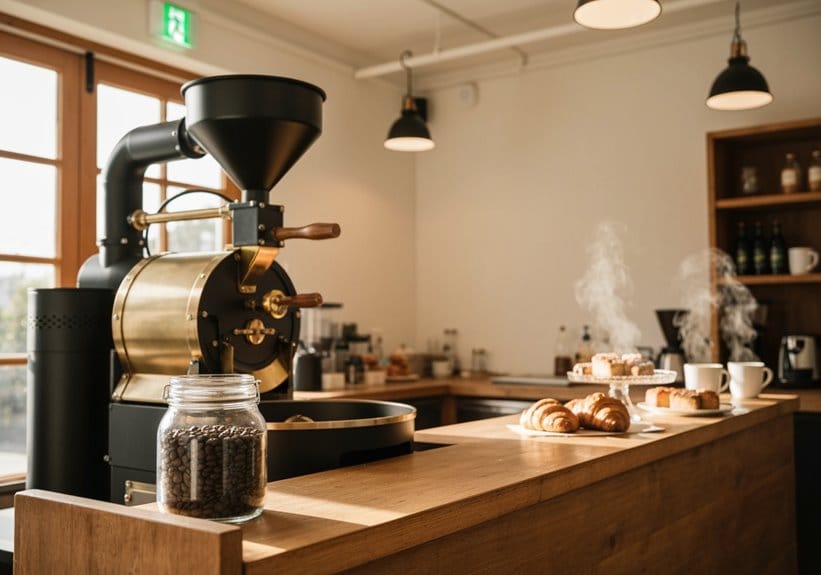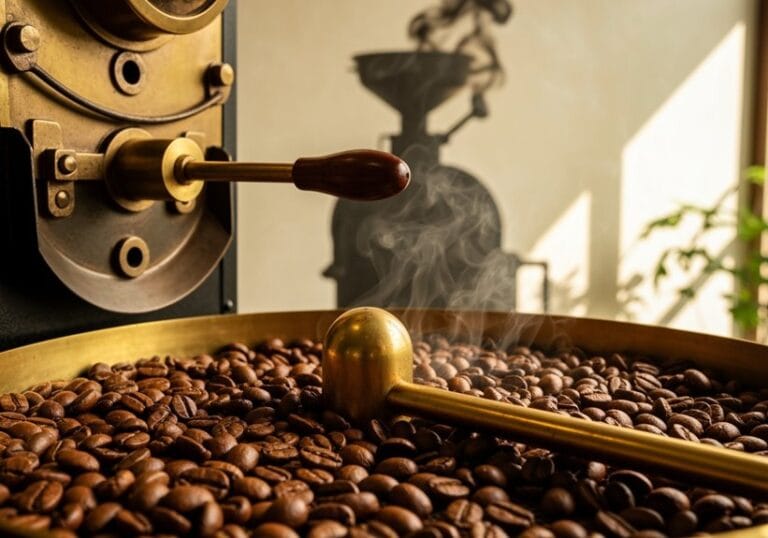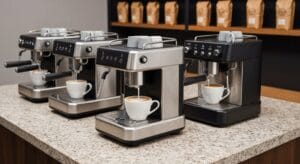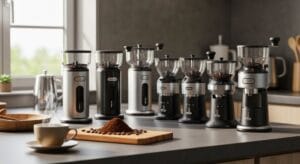Coffee roasting is like magic—green beans go in, and suddenly, you have this aromatic brew! Initially, the beans dry out (goodbye, moisture!), and then the heat kicks in. You’ll hear cracking sounds, almost like popcorn—it’s flavor coming alive! People use different gear, from popcorn poppers (yes, really!) to fancy drum roasters. And hey, if you control the heat just right, you won’t burn your batch! Curious? There’s so much more to investigate!
Key Takeaways
- Start with the drying stage by heating beans to 160°C-200°C to reduce moisture from 10-12% to 2.5%.
- Monitor cracking sounds during roasting, as they indicate flavor development and changes in the beans.
- Understand the Maillard reaction and caramelization process for creating complex flavor profiles in your coffee.
- Choose the right equipment, like popcorn poppers or drum roasters, depending on your batch size and roasting needs.
- Consider environmental factors, such as ambient temperature and airflow, which significantly influence roasting quality and flavors.
Understanding the Stages of Coffee Roasting
As far as coffee roasting is concerned, it’s like a magical transformation—because who doesn’t love a good glow-up?
Initially up is the drying stage, which totally sounds like a spa day for beans. Heating them up to between 160°C and 200°C, most of the moisture evaporates, dropping from 10-12% to just 2.5%. Yep, that’s a serious weight loss! This is crucial because higher elevations can lead to denser beans with a better flavor profile, influencing the roasting process. Bean density significantly affects roasting time, as dense, high-altitude beans require extended roasting.
You’ll hear cracking sounds—no, not the beans saying “ouch!”—but physical changes taking place. Plus, chemical changes! You can almost feel their excitement as acidity and body start developing. Talk about multitasking! Temperature control is essential during this stage to achieve the desired moisture loss for optimal roasting.
Then, the beans hit that yellow hue, revealing their aromatic notes of hay and bread. It’s like they’re waking up, ready for their big moment! Who knew beans had dreams?
The Science Behind Flavor Development
Flavor development in coffee roasting is like a wild chemistry party—where every little bean gets to strut its stuff and show off its unique personality!
The Maillard Reaction kicks off the fun at around 300°F, mixing amino acids and sugars to create delicious flavor compounds. Diverse coffee varieties offer unique flavors, influenced by their specific genetic and environmental factors.
Then, things get sizzling with the caramelization process, turning sugars into sweet goodness above 356°F!
But wait, there’s more! The roast levels—light, medium, dark—determine if your coffee has that bright acidity or rich caramel notes.
And let’s not forget about heat application and airflow control! They’re like the party bouncers, making sure everything’s even and nobody burns!
Moreover, Robusta’s higher caffeine content contributes to its distinct flavor profile, enhancing the overall complexity of the roasted beans.
Essential Equipment and Operating Conditions

Roasting coffee can feel a bit like assembling a spaceship—exciting yet slightly terrifying!
Roasting coffee is an adventure, blending excitement with a hint of fear—much like building your own rocket!
Beginners can launch their coffee dreams with different equipment types. For instance, popcorn poppers—yes, the very same that churn out movie magic—are perfect for tiny batches. Then there are air roasters, like the Fresh Roast models, which whip up evenly roasted beans, much like a hot-air balloon!
For those ready to take flight, drum roasters handle larger loads and look fancy doing it.
Now, operating conditions matter too—think gas burners for sizzling control, or electric ones that keep things cozy and even. Don’t forget about cooling trays! They cool coffee faster than your teen dashes off in embarrassment when you embarrass them! What a ride!
Frequently Asked Questions
How Do I Know When My Coffee Is Roasted Perfectly?
The perfect roast achieves a specific color change, shifting from light to dark brown, while employing diverse roasting techniques. Observing these visual cues alongside auditory signals guarantees peak flavor development and doneness recognition.
Can I Roast Coffee at Home Without Specialized Equipment?
Home coffee roasting is possible without specialized equipment. The stovetop method and oven roasting effectively utilize common kitchen tools, allowing enthusiasts to experiment with roasting techniques while maintaining control over flavor and roast profiles.
What Types of Beans Are Best for Roasting?
The best types of beans for roasting include Arabica beans for their nuanced flavors, Robusta beans for strength, single origin varieties for unique profiles, and blends for balanced complexity. Each offers distinct characteristics for novice roasters.
How Does Altitude Affect Coffee Roasting?
Altitude affects coffee roasting by influencing roasting temperature and time. Higher altitudes require increased temperatures for proper roasting due to lower oxygen levels, while lower altitudes risk burning beans if temperatures are not appropriately adjusted.
What Is the Shelf Life of Roasted Coffee Beans?
Roasted coffee beans typically last up to one year when unopened. Freshness factors include roast level and storage methods; proper storage in airtight, opaque containers minimizes oxidation, maintaining flavor for weeks after opening.
References
- https://www.roasttheory.com/blogs/single-source-coffee/the-science-of-coffee-roasting-a-comprehensive-understanding-of-flavor-transformation
- https://burmancoffee.com/science-of-coffee-roasting/
- https://library.sweetmarias.com/using-sight-to-determine-degree-of-roast/
- https://en.wikipedia.org/wiki/Coffee_roasting





